2016 CHEVROLET COLORADO coolant temperature
[x] Cancel search: coolant temperaturePage 251 of 396
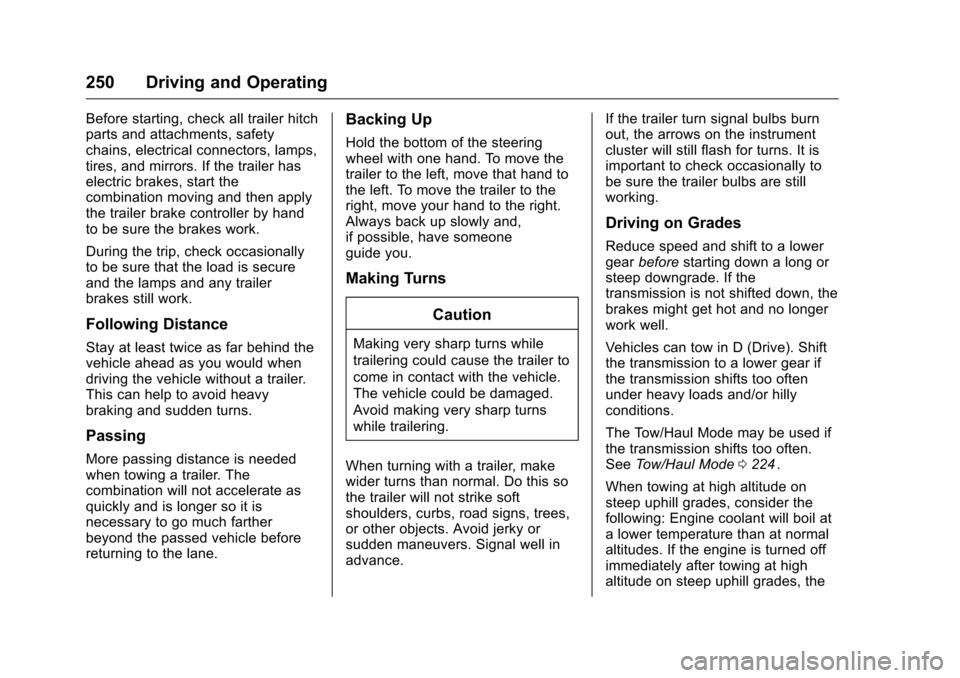
Chevrolet Colorado Owner Manual (GMNA-Localizing-U.S/Canada/Mexico-
9159327) - 2016 - crc - 8/28/15
250 Driving and Operating
Before starting, check all trailer hitch
parts and attachments, safety
chains, electrical connectors, lamps,
tires, and mirrors. If the trailer has
electric brakes, start the
combination moving and then apply
the trailer brake controller by hand
to be sure the brakes work.
During the trip, check occasionally
to be sure that the load is secure
and the lamps and any trailer
brakes still work.
Following Distance
Stay at least twice as far behind the
vehicle ahead as you would when
driving the vehicle without a trailer.
This can help to avoid heavy
braking and sudden turns.
Passing
More passing distance is needed
when towing a trailer. The
combination will not accelerate as
quickly and is longer so it is
necessary to go much farther
beyond the passed vehicle before
returning to the lane.
Backing Up
Hold the bottom of the steering
wheel with one hand. To move the
trailer to the left, move that hand to
the left. To move the trailer to the
right, move your hand to the right.
Always back up slowly and,
if possible, have someone
guide you.
Making TurnsCaution
Making very sharp turns while
trailering could cause the trailer to
come in contact with the vehicle.
The vehicle could be damaged.
Avoid making very sharp turns
while trailering.
When turning with a trailer, make
wider turns than normal. Do this so
the trailer will not strike soft
shoulders, curbs, road signs, trees,
or other objects. Avoid jerky or
sudden maneuvers. Signal well in
advance. If the trailer turn signal bulbs burn
out, the arrows on the instrument
cluster will still flash for turns. It is
important to check occasionally to
be sure the trailer bulbs are still
working.
Driving on Grades
Reduce speed and shift to a lower
gear
before starting down a long or
steep downgrade. If the
transmission is not shifted down, the
brakes might get hot and no longer
work well.
Vehicles can tow in D (Drive). Shift
the transmission to a lower gear if
the transmission shifts too often
under heavy loads and/or hilly
conditions.
The Tow/Haul Mode may be used if
the transmission shifts too often.
See Tow/Haul Mode 0224
ii.
When towing at high altitude on
steep uphill grades, consider the
following: Engine coolant will boil at
a lower temperature than at normal
altitudes. If the engine is turned off
immediately after towing at high
altitude on steep uphill grades, the
Page 272 of 396
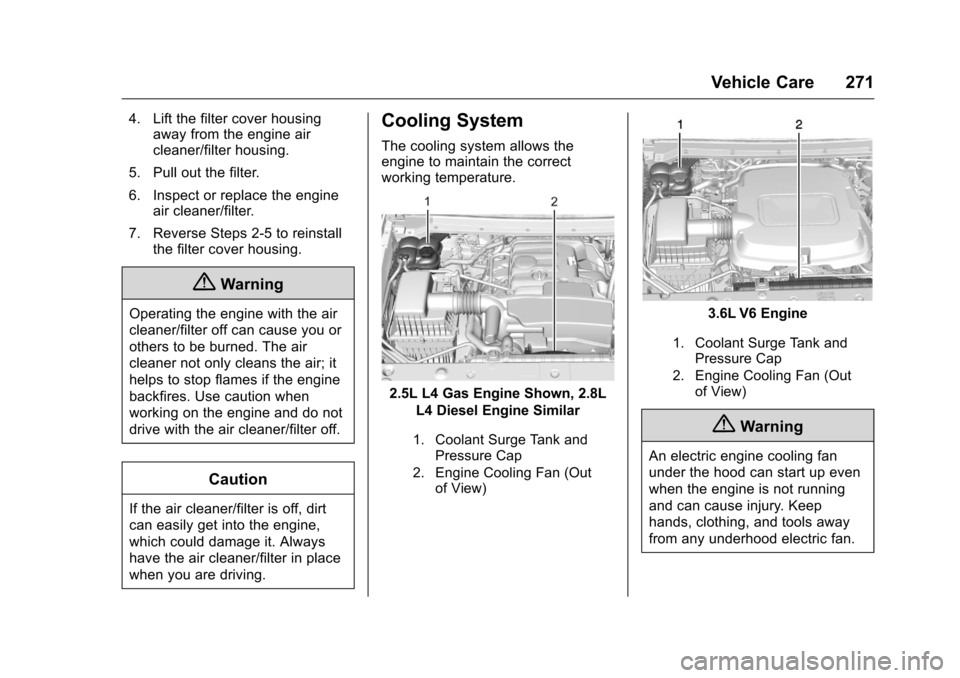
Chevrolet Colorado Owner Manual (GMNA-Localizing-U.S/Canada/Mexico-
9159327) - 2016 - crc - 8/28/15
Vehicle Care 271
4. Lift the filter cover housingaway from the engine air
cleaner/filter housing.
5. Pull out the filter.
6. Inspect or replace the engine air cleaner/filter.
7. Reverse Steps 2-5 to reinstall the filter cover housing.
{Warning
Operating the engine with the air
cleaner/filter off can cause you or
others to be burned. The air
cleaner not only cleans the air; it
helps to stop flames if the engine
backfires. Use caution when
working on the engine and do not
drive with the air cleaner/filter off.
Caution
If the air cleaner/filter is off, dirt
can easily get into the engine,
which could damage it. Always
have the air cleaner/filter in place
when you are driving.
Cooling System
The cooling system allows the
engine to maintain the correct
working temperature.
2.5L L4 Gas Engine Shown, 2.8L
L4 Diesel Engine Similar
1. Coolant Surge Tank andPressure Cap
2. Engine Cooling Fan (Out of View)
3.6L V6 Engine
1. Coolant Surge Tank and
Pressure Cap
2. Engine Cooling Fan (Out of View)
{Warning
An electric engine cooling fan
under the hood can start up even
when the engine is not running
and can cause injury. Keep
hands, clothing, and tools away
from any underhood electric fan.
Page 273 of 396
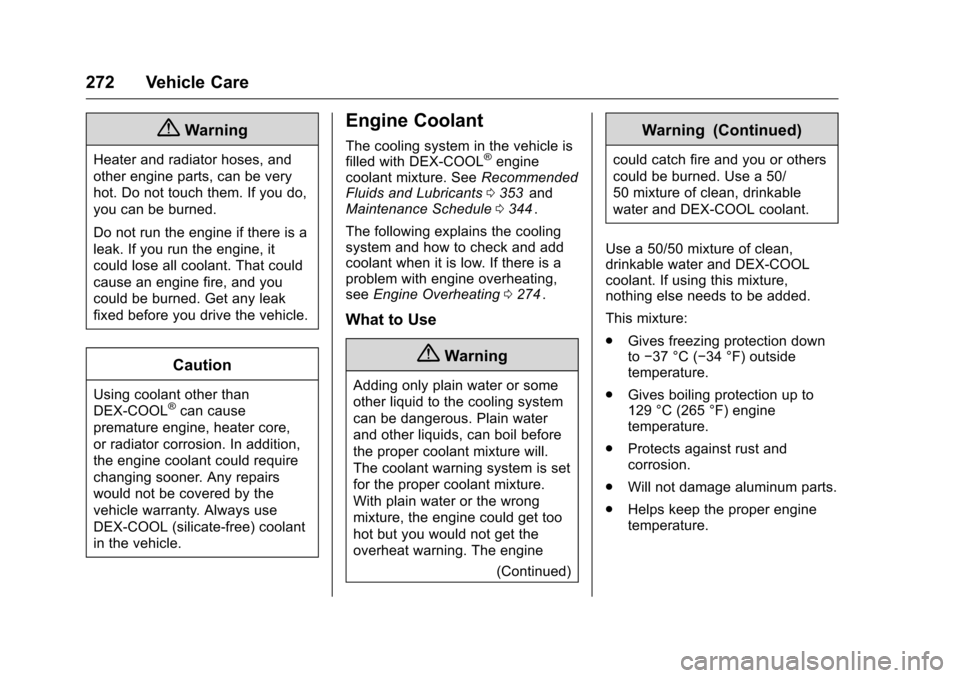
Chevrolet Colorado Owner Manual (GMNA-Localizing-U.S/Canada/Mexico-
9159327) - 2016 - crc - 8/28/15
272 Vehicle Care
{Warning
Heater and radiator hoses, and
other engine parts, can be very
hot. Do not touch them. If you do,
you can be burned.
Do not run the engine if there is a
leak. If you run the engine, it
could lose all coolant. That could
cause an engine fire, and you
could be burned. Get any leak
fixed before you drive the vehicle.
Caution
Using coolant other than
DEX-COOL®can cause
premature engine, heater core,
or radiator corrosion. In addition,
the engine coolant could require
changing sooner. Any repairs
would not be covered by the
vehicle warranty. Always use
DEX-COOL (silicate-free) coolant
in the vehicle.
Engine Coolant
The cooling system in the vehicle is
filled with DEX-COOL®engine
coolant mixture. See Recommended
Fluids and Lubricants 0353
iiand
Maintenance Schedule 0344ii.
The following explains the cooling
system and how to check and add
coolant when it is low. If there is a
problem with engine overheating,
see Engine Overheating 0274
ii.
What to Use
{Warning
Adding only plain water or some
other liquid to the cooling system
can be dangerous. Plain water
and other liquids, can boil before
the proper coolant mixture will.
The coolant warning system is set
for the proper coolant mixture.
With plain water or the wrong
mixture, the engine could get too
hot but you would not get the
overheat warning. The engine
(Continued)
Warning (Continued)
could catch fire and you or others
could be burned. Use a 50/
50 mixture of clean, drinkable
water and DEX-COOL coolant.
Use a 50/50 mixture of clean,
drinkable water and DEX-COOL
coolant. If using this mixture,
nothing else needs to be added.
This mixture:
. Gives freezing protection down
to−37 °C (−34 °F) outside
temperature.
. Gives boiling protection up to
129 °C (265 °F) engine
temperature.
. Protects against rust and
corrosion.
. Will not damage aluminum parts.
. Helps keep the proper engine
temperature.
Page 275 of 396
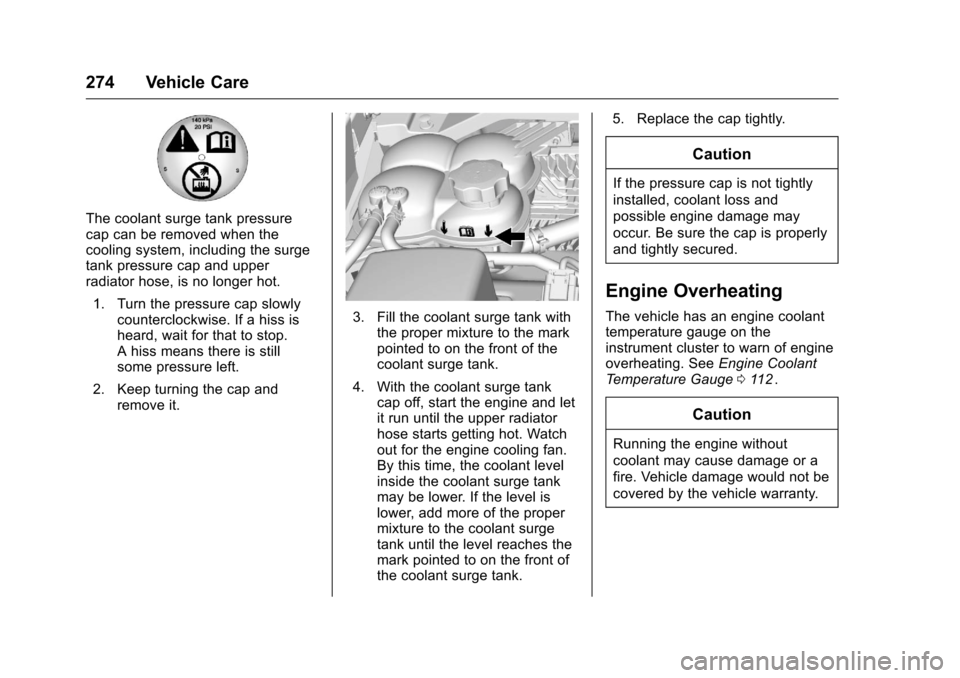
Chevrolet Colorado Owner Manual (GMNA-Localizing-U.S/Canada/Mexico-
9159327) - 2016 - crc - 8/28/15
274 Vehicle Care
The coolant surge tank pressure
cap can be removed when the
cooling system, including the surge
tank pressure cap and upper
radiator hose, is no longer hot.1. Turn the pressure cap slowly counterclockwise. If a hiss is
heard, wait for that to stop.
A hiss means there is still
some pressure left.
2. Keep turning the cap and remove it.
3. Fill the coolant surge tank withthe proper mixture to the mark
pointed to on the front of the
coolant surge tank.
4. With the coolant surge tank cap off, start the engine and let
it run until the upper radiator
hose starts getting hot. Watch
out for the engine cooling fan.
By this time, the coolant level
inside the coolant surge tank
may be lower. If the level is
lower, add more of the proper
mixture to the coolant surge
tank until the level reaches the
mark pointed to on the front of
the coolant surge tank. 5. Replace the cap tightly.
Caution
If the pressure cap is not tightly
installed, coolant loss and
possible engine damage may
occur. Be sure the cap is properly
and tightly secured.
Engine Overheating
The vehicle has an engine coolant
temperature gauge on the
instrument cluster to warn of engine
overheating. See
Engine Coolant
Temperature Gauge 0112
ii.
Caution
Running the engine without
coolant may cause damage or a
fire. Vehicle damage would not be
covered by the vehicle warranty.
Page 276 of 396
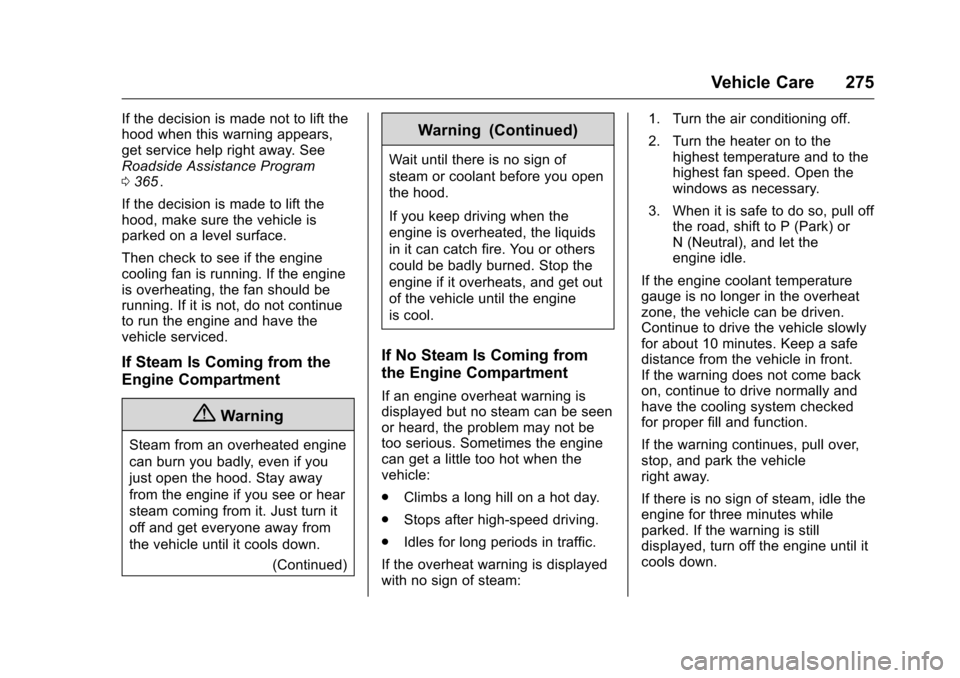
Chevrolet Colorado Owner Manual (GMNA-Localizing-U.S/Canada/Mexico-
9159327) - 2016 - crc - 8/28/15
Vehicle Care 275
If the decision is made not to lift the
hood when this warning appears,
get service help right away. See
Roadside Assistance Program
0365
ii.
If the decision is made to lift the
hood, make sure the vehicle is
parked on a level surface.
Then check to see if the engine
cooling fan is running. If the engine
is overheating, the fan should be
running. If it is not, do not continue
to run the engine and have the
vehicle serviced.
If Steam Is Coming from the
Engine Compartment
{Warning
Steam from an overheated engine
can burn you badly, even if you
just open the hood. Stay away
from the engine if you see or hear
steam coming from it. Just turn it
off and get everyone away from
the vehicle until it cools down. (Continued)
Warning (Continued)
Wait until there is no sign of
steam or coolant before you open
the hood.
If you keep driving when the
engine is overheated, the liquids
in it can catch fire. You or others
could be badly burned. Stop the
engine if it overheats, and get out
of the vehicle until the engine
is cool.
If No Steam Is Coming from
the Engine Compartment
If an engine overheat warning is
displayed but no steam can be seen
or heard, the problem may not be
too serious. Sometimes the engine
can get a little too hot when the
vehicle:
.Climbs a long hill on a hot day.
. Stops after high-speed driving.
. Idles for long periods in traffic.
If the overheat warning is displayed
with no sign of steam: 1. Turn the air conditioning off.
2. Turn the heater on to the
highest temperature and to the
highest fan speed. Open the
windows as necessary.
3. When it is safe to do so, pull off the road, shift to P (Park) or
N (Neutral), and let the
engine idle.
If the engine coolant temperature
gauge is no longer in the overheat
zone, the vehicle can be driven.
Continue to drive the vehicle slowly
for about 10 minutes. Keep a safe
distance from the vehicle in front.
If the warning does not come back
on, continue to drive normally and
have the cooling system checked
for proper fill and function.
If the warning continues, pull over,
stop, and park the vehicle
right away.
If there is no sign of steam, idle the
engine for three minutes while
parked. If the warning is still
displayed, turn off the engine until it
cools down.
Page 277 of 396
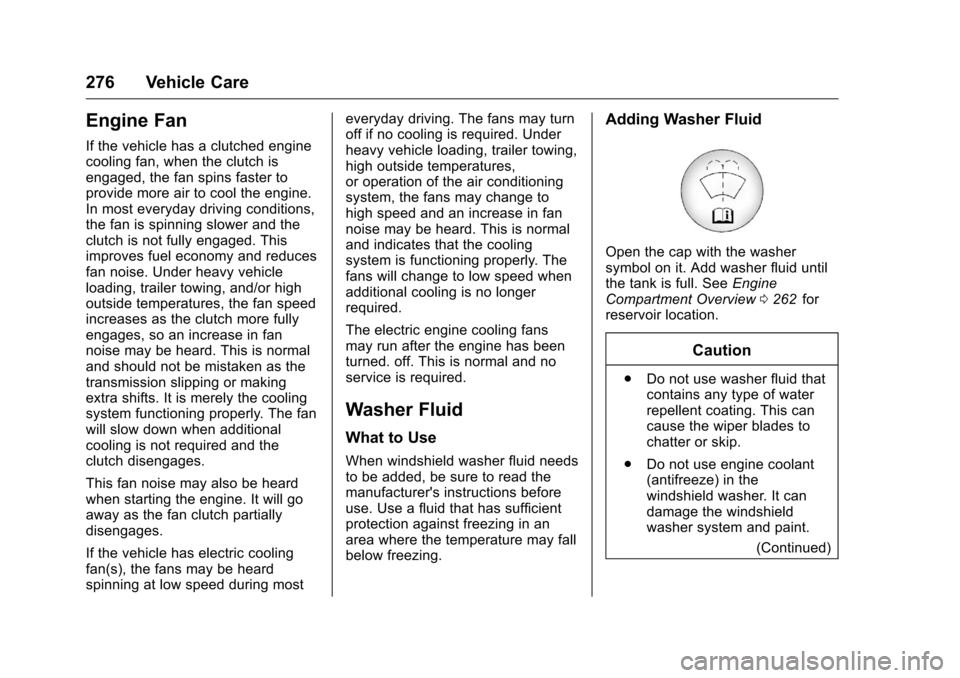
Chevrolet Colorado Owner Manual (GMNA-Localizing-U.S/Canada/Mexico-
9159327) - 2016 - crc - 8/28/15
276 Vehicle Care
Engine Fan
If the vehicle has a clutched engine
cooling fan, when the clutch is
engaged, the fan spins faster to
provide more air to cool the engine.
In most everyday driving conditions,
the fan is spinning slower and the
clutch is not fully engaged. This
improves fuel economy and reduces
fan noise. Under heavy vehicle
loading, trailer towing, and/or high
outside temperatures, the fan speed
increases as the clutch more fully
engages, so an increase in fan
noise may be heard. This is normal
and should not be mistaken as the
transmission slipping or making
extra shifts. It is merely the cooling
system functioning properly. The fan
will slow down when additional
cooling is not required and the
clutch disengages.
This fan noise may also be heard
when starting the engine. It will go
away as the fan clutch partially
disengages.
If the vehicle has electric cooling
fan(s), the fans may be heard
spinning at low speed during mosteveryday driving. The fans may turn
off if no cooling is required. Under
heavy vehicle loading, trailer towing,
high outside temperatures,
or operation of the air conditioning
system, the fans may change to
high speed and an increase in fan
noise may be heard. This is normal
and indicates that the cooling
system is functioning properly. The
fans will change to low speed when
additional cooling is no longer
required.
The electric engine cooling fans
may run after the engine has been
turned. off. This is normal and no
service is required.
Washer Fluid
What to Use
When windshield washer fluid needs
to be added, be sure to read the
manufacturer's instructions before
use. Use a fluid that has sufficient
protection against freezing in an
area where the temperature may fall
below freezing.
Adding Washer Fluid
Open the cap with the washer
symbol on it. Add washer fluid until
the tank is full. See
Engine
Compartment Overview 0262
iifor
reservoir location.
Caution
. Do not use washer fluid that
contains any type of water
repellent coating. This can
cause the wiper blades to
chatter or skip.
. Do not use engine coolant
(antifreeze) in the
windshield washer. It can
damage the windshield
washer system and paint.
(Continued)
Page 388 of 396
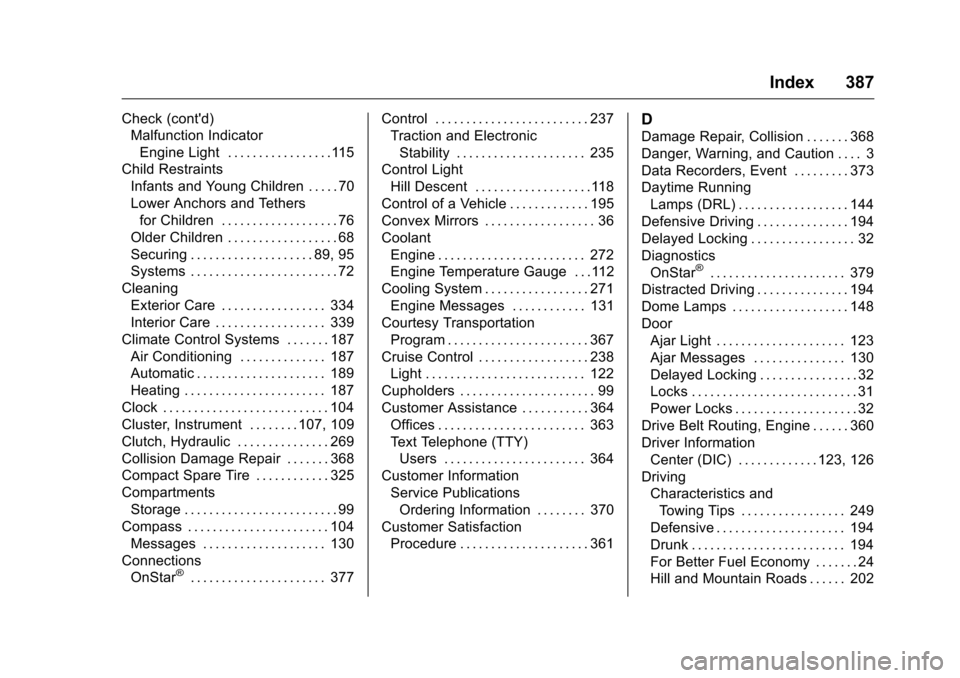
Chevrolet Colorado Owner Manual (GMNA-Localizing-U.S/Canada/Mexico-
9159327) - 2016 - crc - 8/28/15
Index 387
Check (cont'd)Malfunction Indicator
Engine Light . . . . . . . . . . . . . . . . .115
Child Restraints
Infants and Young Children . . . . . 70
Lower Anchors and Tethersfor Children . . . . . . . . . . . . . . . . . . . 76
Older Children . . . . . . . . . . . . . . . . . . 68
Securing . . . . . . . . . . . . . . . . . . . . 89, 95
Systems . . . . . . . . . . . . . . . . . . . . . . . . 72
Cleaning Exterior Care . . . . . . . . . . . . . . . . . 334
Interior Care . . . . . . . . . . . . . . . . . . 339
Climate Control Systems . . . . . . . 187
Air Conditioning . . . . . . . . . . . . . . 187
Automatic . . . . . . . . . . . . . . . . . . . . . 189
Heating . . . . . . . . . . . . . . . . . . . . . . . 187
Clock . . . . . . . . . . . . . . . . . . . . . . . . . . . 104
Cluster, Instrument . . . . . . . . 107, 109
Clutch, Hydraulic . . . . . . . . . . . . . . . 269
Collision Damage Repair . . . . . . . 368
Compact Spare Tire . . . . . . . . . . . . 325
Compartments
Storage . . . . . . . . . . . . . . . . . . . . . . . . . 99
Compass . . . . . . . . . . . . . . . . . . . . . . . 104 Messages . . . . . . . . . . . . . . . . . . . . 130
Connections OnStar
®. . . . . . . . . . . . . . . . . . . . . . 377 Control . . . . . . . . . . . . . . . . . . . . . . . . . 237
Traction and Electronic
Stability . . . . . . . . . . . . . . . . . . . . . 235
Control Light Hill Descent . . . . . . . . . . . . . . . . . . .118
Control of a Vehicle . . . . . . . . . . . . . 195
Convex Mirrors . . . . . . . . . . . . . . . . . . 36
Coolant Engine . . . . . . . . . . . . . . . . . . . . . . . . 272
Engine Temperature Gauge . . .112
Cooling System . . . . . . . . . . . . . . . . . 271
Engine Messages . . . . . . . . . . . . 131
Courtesy Transportation Program . . . . . . . . . . . . . . . . . . . . . . . 367
Cruise Control . . . . . . . . . . . . . . . . . . 238 Light . . . . . . . . . . . . . . . . . . . . . . . . . . 122
Cupholders . . . . . . . . . . . . . . . . . . . . . . 99
Customer Assistance . . . . . . . . . . . 364 Offices . . . . . . . . . . . . . . . . . . . . . . . . 363
Text Telephone (TTY)Users . . . . . . . . . . . . . . . . . . . . . . . 364
Customer Information Service PublicationsOrdering Information . . . . . . . . 370
Customer Satisfaction
Procedure . . . . . . . . . . . . . . . . . . . . . 361
D
Damage Repair, Collision . . . . . . . 368
Danger, Warning, and Caution . . . . 3
Data Recorders, Event . . . . . . . . . 373
Daytime RunningLamps (DRL) . . . . . . . . . . . . . . . . . . 144
Defensive Driving . . . . . . . . . . . . . . . 194
Delayed Locking . . . . . . . . . . . . . . . . . 32
Diagnostics OnStar
®. . . . . . . . . . . . . . . . . . . . . . 379
Distracted Driving . . . . . . . . . . . . . . . 194
Dome Lamps . . . . . . . . . . . . . . . . . . . 148
Door Ajar Light . . . . . . . . . . . . . . . . . . . . . 123
Ajar Messages . . . . . . . . . . . . . . . 130
Delayed Locking . . . . . . . . . . . . . . . . 32
Locks . . . . . . . . . . . . . . . . . . . . . . . . . . . 31
Power Locks . . . . . . . . . . . . . . . . . . . . 32
Drive Belt Routing, Engine . . . . . . 360
Driver Information
Center (DIC) . . . . . . . . . . . . . 123, 126
Driving Characteristics andTowing Tips . . . . . . . . . . . . . . . . . 249
Defensive . . . . . . . . . . . . . . . . . . . . . 194
Drunk . . . . . . . . . . . . . . . . . . . . . . . . . 194
For Better Fuel Economy . . . . . . . 24
Hill and Mountain Roads . . . . . . 202
Page 389 of 396
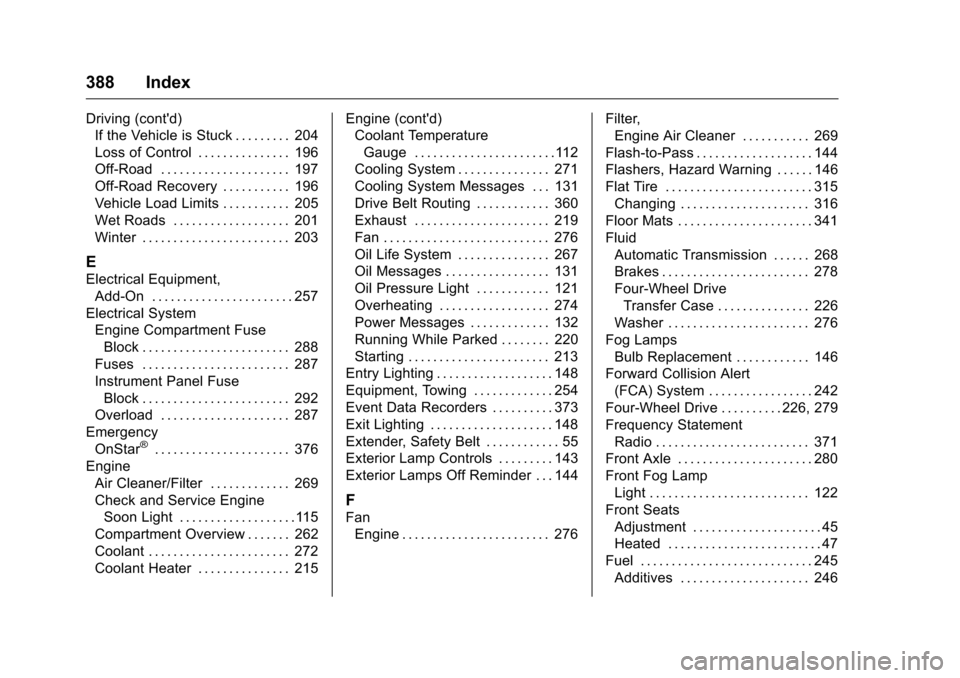
Chevrolet Colorado Owner Manual (GMNA-Localizing-U.S/Canada/Mexico-
9159327) - 2016 - crc - 8/28/15
388 Index
Driving (cont'd)If the Vehicle is Stuck . . . . . . . . . 204
Loss of Control . . . . . . . . . . . . . . . 196
Off-Road . . . . . . . . . . . . . . . . . . . . . 197
Off-Road Recovery . . . . . . . . . . . 196
Vehicle Load Limits . . . . . . . . . . . 205
Wet Roads . . . . . . . . . . . . . . . . . . . 201
Winter . . . . . . . . . . . . . . . . . . . . . . . . 203
E
Electrical Equipment,
Add-On . . . . . . . . . . . . . . . . . . . . . . . 257
Electrical System Engine Compartment Fuse
Block . . . . . . . . . . . . . . . . . . . . . . . . 288
Fuses . . . . . . . . . . . . . . . . . . . . . . . . 287
Instrument Panel Fuse Block . . . . . . . . . . . . . . . . . . . . . . . . 292
Overload . . . . . . . . . . . . . . . . . . . . . 287
Emergency OnStar
®. . . . . . . . . . . . . . . . . . . . . . 376
Engine Air Cleaner/Filter . . . . . . . . . . . . . 269
Check and Service EngineSoon Light . . . . . . . . . . . . . . . . . . .115
Compartment Overview . . . . . . . 262
Coolant . . . . . . . . . . . . . . . . . . . . . . . 272
Coolant Heater . . . . . . . . . . . . . . . 215 Engine (cont'd)
Coolant Temperature
Gauge . . . . . . . . . . . . . . . . . . . . . . .112
Cooling System . . . . . . . . . . . . . . . 271
Cooling System Messages . . . 131
Drive Belt Routing . . . . . . . . . . . . 360
Exhaust . . . . . . . . . . . . . . . . . . . . . . 219
Fan . . . . . . . . . . . . . . . . . . . . . . . . . . . 276
Oil Life System . . . . . . . . . . . . . . . 267
Oil Messages . . . . . . . . . . . . . . . . . 131
Oil Pressure Light . . . . . . . . . . . . 121
Overheating . . . . . . . . . . . . . . . . . . 274
Power Messages . . . . . . . . . . . . . 132
Running While Parked . . . . . . . . 220
Starting . . . . . . . . . . . . . . . . . . . . . . . 213
Entry Lighting . . . . . . . . . . . . . . . . . . . 148
Equipment, Towing . . . . . . . . . . . . . 254
Event Data Recorders . . . . . . . . . . 373
Exit Lighting . . . . . . . . . . . . . . . . . . . . 148
Extender, Safety Belt . . . . . . . . . . . . 55
Exterior Lamp Controls . . . . . . . . . 143
Exterior Lamps Off Reminder . . . 144
F
Fan Engine . . . . . . . . . . . . . . . . . . . . . . . . 276 Filter,
Engine Air Cleaner . . . . . . . . . . . 269
Flash-to-Pass . . . . . . . . . . . . . . . . . . . 144
Flashers, Hazard Warning . . . . . . 146
Flat Tire . . . . . . . . . . . . . . . . . . . . . . . . 315 Changing . . . . . . . . . . . . . . . . . . . . . 316
Floor Mats . . . . . . . . . . . . . . . . . . . . . . 341
Fluid
Automatic Transmission . . . . . . 268
Brakes . . . . . . . . . . . . . . . . . . . . . . . . 278
Four-Wheel DriveTransfer Case . . . . . . . . . . . . . . . 226
Washer . . . . . . . . . . . . . . . . . . . . . . . 276
Fog Lamps Bulb Replacement . . . . . . . . . . . . 146
Forward Collision Alert
(FCA) System . . . . . . . . . . . . . . . . . 242
Four-Wheel Drive . . . . . . . . . . 226, 279
Frequency Statement Radio . . . . . . . . . . . . . . . . . . . . . . . . . 371
Front Axle . . . . . . . . . . . . . . . . . . . . . . 280
Front Fog Lamp
Light . . . . . . . . . . . . . . . . . . . . . . . . . . 122
Front Seats Adjustment . . . . . . . . . . . . . . . . . . . . . 45
Heated . . . . . . . . . . . . . . . . . . . . . . . . . 47
Fuel . . . . . . . . . . . . . . . . . . . . . . . . . . . . 245 Additives . . . . . . . . . . . . . . . . . . . . . 246